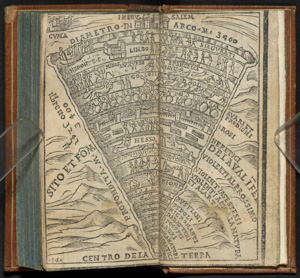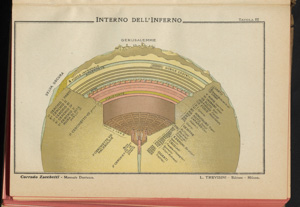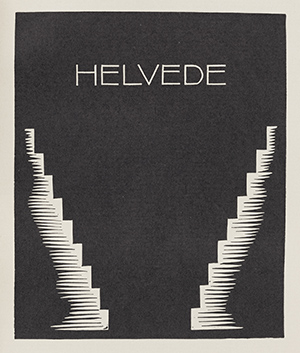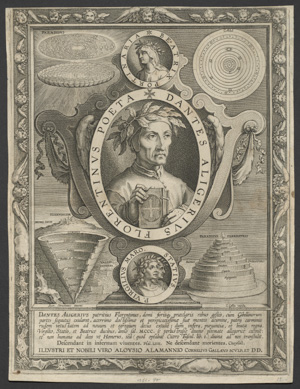Selected Themes from the Divine Comedy
Mapping Hell
Dante’s structure of hell is a marvel of his inventive mind, but is not merely an accompaniment to the theological conception of the punishment of sin. It also depends more holistically on Dante’s wide-ranging knowledge of geometry and geography as understood from the writings of ancient scholars Euclid and Ptolemy, preserved in manuscripts across the intervening centuries.
Dante describes Hell as a funnel or inverted cone descending in nine diminishing rings until the center of the earth (also the center of the universe in the geocentric understanding of his day) is reached. After reaching the center of the earth at the deepest part of Hell, Dante and Virgil begin their ascent to Purgatory.
Unidentified artist
Italian, 16th century
Schematic Diagrams of the Circles of Hell, in
Dante col sito, et forma dell' inferno, aka « Il Dantino » (the tiny Dante), [Venice]: Alex[andro] Paganin[i], 1515 and 1516 editions
Woodcut
3 1/4 x 3 1/4 inches (8.26 x 8.26 cm)
Cornell University Library, Rare and Manuscript Collections
(2 images)
Alessandro Paganini was an innovative papermaker, printer, and publisher, active both on the shores of Lake Garda and in Venice. He is credited with the invention of the editorial series — that is, editions of Dante, Petrarch, Bembo, etc. sharing the same characteristics and format: in this case, a very compact “twenty-fourmo” (1/24th of a normal paper sheet). The 1515 Dante is the smallest Commedia of the Renaissance. It is dedicated to none other than Cardinal Giulio de' Medici, who reigned as Pope Clement VII from 1523 to 1534. The edition was so popular that it was reprinted in 1516, in an even smaller format (1/36th!), both on vellum and on paper. These editions were highly sought-after by 19th century book collectors such as the artist, dealer and great art collector Charles Fairfax Murray, a friend of William Morris and John Ruskin.
These two “jewel editions” each contain 1) a double-page diagram showing Jerusalem (spelled “IHERVSALEM” with the aspirate H expressing the breath of Life), Limbo, Hell, and the alleged center of the Earth (“centro della Terra”), and 2) another woodcut diagram about the spatial organization of Purgatory.
Corrado Zacchetti
Italian, 1871–1940
Diagram : The interior of Hell, in
Manuale dantesco per le scuole…(Dante Textbook for Schools)
Milan: Trevisini, 1918
Diagram: 4 1/8 x 6 1/2 inches (10.48 x 16.51 cm)
Cornell University Library, Rare and Manuscript Collections
(1 image)
In the late 1890s, the poet and literary critic Corrado Zacchetti made a name for himself with his psychological and stylistic interpretations of the Divine Comedy. He famously defended Dante against allegations of cannibalism in Canto 33 of Inferno, and that the famous line, “Hunger had more power than even sorrow over me” simply meant that that starvation killed Ugolino della Gherardesca (see John Dixon,Count Ugolino and His Children) after he had failed to die of grief. Later, he recycled observations like these manuals for schoolchildren, such as this one. Like the Paganini editions shown above, Zacchetti’s textbook included a diagram of Hell. Perhaps because the book was for young readers, who would have been otherwise familiar with the mythological and monstrous figures encountered by Dante and Virgil, they are listed in bold next to their respective circles of Hell.
Ebba Holm
Danish, 1889–1967
Section heading for Inferno, in Guddommelige komedie
Copenhagen, G.E.C. Gads Forlag, 1929
Linocut
Image: 5 1/4 x 4 3/8 inches (13.34 x 11.11 cm)
Cornell University Library, Rare and Manuscript Collections
(1 image)
A painter, engraver and illustrator, Holm became best known for her 108 linocut illustrations to a 1929 Danish translation of Dante’s Divine Comedy by Christian Knud Frederik Molbech. Her geometrical and minimalist rendition of the different circles of Hell is particularly striking. The image has much in common with contemporary Art Deco designs, such as Oliver Percy Bernard’s grand staircase in the foyer of the Strand Palace Hotel in London (1930).
Cornelis Galle
Flemish, 1576–1650
after Johannes Stradanus
Flemish, 1523–1605
Dante, Beatrice, Virgil, and Statius, ca. 1595–1603
Engraving
Cornell University Library, Rare and Manuscript Collections
(1 image)
This print after a drawing by Stradanus, a former court artist to the Medici ruling family of Florence, surrounds Dante’s portrait oval with a schematic summary of his journey. At the bottom appear portraits of Dante’s guides through Inferno and Purgatory Virgil and Statius (ca. 45–96 CE). They appear in the same circular frame because Statius was a devotee of Virgil. Dante portrays Statius as a clandestine Christian convert, a fiction that allows him to use him as a guide in Purgatory, where Virgil is not admitted.
Virgil and Statius are flanked by the seven circles of hell in the shape of an inverted cone, while Mt. Purgatory’s concentric terraces rise like a layer cake. Above, the portrait of Beatrice gazes beatifically on the schema of Paradiso, with tiny figures of herself and Dante at the center. This print was likely produced as the frontispiece to a series of engravings of the Divine Comedy after drawings by Stradanus, which was never realized.[1] The dedication to Luigi Alamanni (1558–1603), a Dante scholar and collaborator with Stradanus, adds further support to this idea.
Footnotes
[1] Manfred Sellink, “Lucifer,” Bulletin van het Rijksmuseum, vol. 35, No. 2 (1987), 100. ↩



